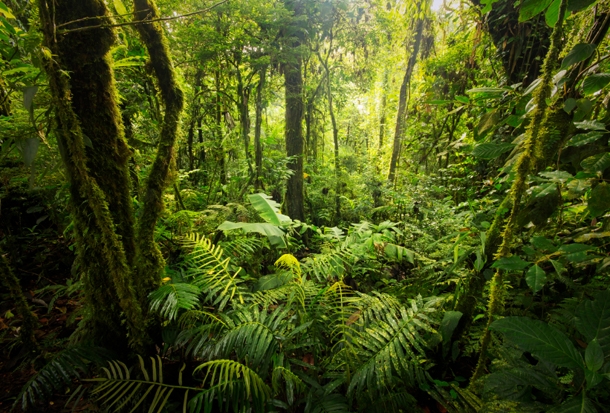When I suggested that I might build a little tin house in the subtropical rainforest of south-east Queensland, I was advised by well-meaning folk that this probably wasn’t a very good idea. The forest would close in over the house; mildew and algae would grow on everything including me; the sun would not get above the surrounding scarps on the eastern side till mid-morning, only to plummet out of sight behind the scarps on the western side halfway through the afternoon — not that I’d notice, being penned in perpetual gloom under the forest canopy. All true. And no one to talk to but spiders and snakes.
There are certainly many spiders. I do talk to them, shout at them, actually, because when I do they flinch and try to run away. Unfortunately in their panic they too often end up running straight at me. There are so many snakes that kookaburras bring their fledglings to the garden for predation training. The babies get bored with the long wait motionless on a branch, and grumble under their breath, but the parents will have none of it. The fledglings have to sit there until they have done at least one successful dive on a reptile; then, amid manic howls of celebration from their parents and older siblings, they will finally be allowed to fly off and play.
The reptile count this year is very high, probably because, as the summer was unusually hot and dry, more lizard eggs hatched. Every day a full-grown male monitor lizard makes his round through the rainforest garden, unmoved by the clattering alarm calls from the forest birds. He eats baby skinks like whitebait, by the dozen.
I am used to the two kinds of tree snakes that have taken up residence in the ironwork that supports the house, but the small-eyed black snake that decided to look for a sunlit basking place on the verandah was a different matter. As I came round the corner from hanging out the washing, I all but trod on him. I was in his way and he was in mine. How a clumsy old woman and a terrified and dangerous snake managed to avoid each other is more than I can tell.
No sooner did the newly planted trees begin to cast shade than the rainforest mammals returned. These days, two kinds of pademelons, the ones with red necks and the others with red legs, come thumping into the garden to eat the native violets. At night spotted-tailed quolls can be heard screaming. Two kinds of bandicoot busy themselves digging up leatherjackets and centipedes. An echidna occasionally trundles past. Thirteen kinds of bat come winging by, most at dawn or dusk, and some all night long. When I left a sack of rubbish on the verandah overnight, having forgotten to load it into the car for delivery to the recycling site, bush rats broke into it in search of the spoiled digestive biscuits, leaving a collection of glossy black turds and a disembowelled teabag in exchange.
A week ago a family of black-striped wallabies stole into the garden to eat fallen leaves. These they selected for yellowness, holding them as daintily and biting them as neatly as if they were breakfasting at -Claridge’s. They also nipped the green leaves off a quantity of prized plants, all of them rare and now probably dead. This means wasted effort on my part, but that is not the point. The forest is working, and the failure of my misguided contribution makes no odds.
For the last few years a small number of dedicated locals have been trying to beef up the numbers of the threatened Richmond birdwing butterfly. The male is iridescent emerald and velvet black; the female is bigger, blousier and browner. Both used to fly in clouds in the rainforest; their larval food plant was a genus of native vines we now call Pararistolochia, to distinguish it from a related exotic, Aristolochia or ‘Dutchman’s pipe’. As the native forests were felled and burnt, the butterflies had no option but to lay their eggs on the European species they found in suburban gardens. This was toxic to their caterpillars. Within a very short time, the Richmond birdwing was close to extinction in the wild.
Five years ago I planted a dozen specimens of Pararistolochia praevenosa round the little tin house. It was more than I could hope for that the remaining birdwings would find them and remember what to do with them. But they did. For weeks the rainforest garden has been shimmering with the fanning wings of the big females as they besiege the vines that are now growing through the canopy. Yesterday, for the first time, we saw the smaller males, fresh from the chrysalis, drying their jewelled wings.
Today, driving back to the house from the nursery, I surprised what I thought was a baby pademelon but, instead of bounding away as pademelons always do, it propped itself on its tail and turned to look at the car. I lowered the window and spoke to it. Too tame for its own good, it gazed at me still, and I could see that it had a longer snout and shorter ears than a pademelon, and no part of its body was russet. It was a long-nosed potoroo. This little macropod was first seen in 1789 when the first settlers arrived at Botany Bay; as they cleared the forest, the potoroo disappeared with it. The wonder is that if you bring back the forest, the few survivors of species like the potoroo will find it.
Beleaguered though they certainly are, Australian native species are better at surviving than Australian industries are proving to be. In South Australia the future of the last steel plant in Whyalla hangs in the balance, the current owners having no way of servicing their vast debt of 4 billion Australian dollars. A week ago the last refrigerator to be manufactured in Australia rolled off the assembly line at the Electrolux factory in the New South Wales town of Orange. When Toyota, Ford and General Motors Holden cease Australian operations next year, no more cars will be built in Australia. Queensland Nickel is in liquidation, Peabody Energy in trouble. But Australia still has something to sell. Live cattle export has increased, is increasing and expected to increase further as Australia enters into billion-dollar deals with China, despite the fact that more than three-quarters of the Australian population believes live export to be intolerably cruel. It seems Australians can no longer afford the moral high ground. Perhaps we never could.
Dark and soggy as my forest may be, its very leeches tell me that all is not lost. There is enough energy in the system to rebuild all the threatened populations, if we will only give it the chance. If only we could afford to give it the chance.






Comments